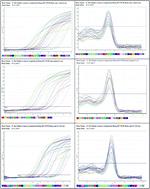当前位置:
X-MOL 学术
›
Toxicol. Res.
›
论文详情
Our official English website, www.x-mol.net, welcomes your
feedback! (Note: you will need to create a separate account there.)
Synergistic antioxidant capacity of CsNPs and CurNPs against cytotoxicity, genotoxicity and pro-inflammatory mediators induced by hydroxyapatite nanoparticles in male rats.
Toxicology Research ( IF 2.2 ) Pub Date : 2019-10-22 , DOI: 10.1039/c9tx00221a Israa F Mosa 1 , Mokhtar Youssef 2 , Maher Kamel 3 , Osama F Mosa 4 , Yasser Helmy 5
Toxicology Research ( IF 2.2 ) Pub Date : 2019-10-22 , DOI: 10.1039/c9tx00221a Israa F Mosa 1 , Mokhtar Youssef 2 , Maher Kamel 3 , Osama F Mosa 4 , Yasser Helmy 5
Affiliation

|
Due to their dynamic characteristics, hydroxyapatite nanoparticles (HAP-NPs) have been employed numerous times in nanomedicine and in tissue engineering, particularly as diagnostic and therapeutic agents. However, there are outstanding findings from various studies that question whether these NPs are safe when they are used in the human body. Therefore, a more in-depth toxicity assessment should be carried out to give a clear answer regarding the fate of these particles. Here we aim to investigate the possible cytotoxicity, genotoxicity and inflammation induced by HAP-NPs, as well as predict the synergistic antioxidative effect of chitosan nanoparticles (CsNPs) and curcumin nanoparticles (CurNPs) in mitigating this pronounced toxicity. The present study was conducted on eighty Wistar male rats, divided into eight equal groups. The results showed that, at the molecular level, HAP-NPs significantly induced gene expression of tumor suppressor protein p53, tumor necrosis factor-α (TNF-α), interleukin-6 (IL-6) and also Kidney Injury Molecule-1 (KIM-1) and Lipocalin-2 (LCN2). In addition, kidney biochemical parameters (total bilirubin, urea, uric acid and creatinine) increased, but albumin levels decreased in the group treated with HAP-NPs alone. Meanwhile, co-treatment with CsNPs and/or CurNPs with HAP-NPs showed an improvement in the activities of the kidney parameters and reduced inflammation. This study shows that the nephrotoxicity mechanism of HAP-NPs may involve various signaling pathways including alterations in biochemical parameters, gene expression of KIM-1 and LCN2 and disturbing the production of cytokines and p53. Furthermore, these insights showed that the combined effect of both CsNPs and CurNPs was more pronounced than the effect of each one on its own.
中文翻译:

CsNPs 和 CurNPs 对雄性大鼠中羟基磷灰石纳米颗粒诱导的细胞毒性、遗传毒性和促炎介质的协同抗氧化能力。
由于其动态特性,羟基磷灰石纳米粒子 (HAP-NPs) 已在纳米医学和组织工程中多次使用,特别是作为诊断和治疗剂。然而,各种研究的突出发现质疑这些 NP 在人体中使用时是否安全。因此,应进行更深入的毒性评估,以明确回答这些颗粒的归宿。在这里,我们旨在研究 HAP-NPs 可能引起的细胞毒性、遗传毒性和炎症,并预测壳聚糖纳米粒子 (CsNPs) 和姜黄素纳米粒子 (CurNPs) 在减轻这种明显毒性方面的协同抗氧化作用。本研究对 80 只 Wistar 雄性大鼠进行,分为 8 个相等的组。结果表明,在分子水平上,HAP-NPs显着诱导肿瘤抑制蛋白p53、肿瘤坏死因子-α(TNF-α)、白介素-6(IL-6)和肾损伤分子-1的基因表达。 KIM-1) 和 Lipocalin-2 (LCN2)。此外,仅用 HAP-NPs 治疗的组肾脏生化参数(总胆红素、尿素、尿酸和肌酐)增加,但白蛋白水平降低。同时,CsNPs 和/或 CurNPs 与 HAP-NPs 的共同治疗显示肾脏参数活动的改善和炎症减少。本研究表明,HAP-NPs 的肾毒性机制可能涉及多种信号通路,包括生化参数的改变、KIM-1 和 LCN2 的基因表达以及干扰细胞因子和 p53 的产生。此外,
更新日期:2019-10-22
中文翻译:

CsNPs 和 CurNPs 对雄性大鼠中羟基磷灰石纳米颗粒诱导的细胞毒性、遗传毒性和促炎介质的协同抗氧化能力。
由于其动态特性,羟基磷灰石纳米粒子 (HAP-NPs) 已在纳米医学和组织工程中多次使用,特别是作为诊断和治疗剂。然而,各种研究的突出发现质疑这些 NP 在人体中使用时是否安全。因此,应进行更深入的毒性评估,以明确回答这些颗粒的归宿。在这里,我们旨在研究 HAP-NPs 可能引起的细胞毒性、遗传毒性和炎症,并预测壳聚糖纳米粒子 (CsNPs) 和姜黄素纳米粒子 (CurNPs) 在减轻这种明显毒性方面的协同抗氧化作用。本研究对 80 只 Wistar 雄性大鼠进行,分为 8 个相等的组。结果表明,在分子水平上,HAP-NPs显着诱导肿瘤抑制蛋白p53、肿瘤坏死因子-α(TNF-α)、白介素-6(IL-6)和肾损伤分子-1的基因表达。 KIM-1) 和 Lipocalin-2 (LCN2)。此外,仅用 HAP-NPs 治疗的组肾脏生化参数(总胆红素、尿素、尿酸和肌酐)增加,但白蛋白水平降低。同时,CsNPs 和/或 CurNPs 与 HAP-NPs 的共同治疗显示肾脏参数活动的改善和炎症减少。本研究表明,HAP-NPs 的肾毒性机制可能涉及多种信号通路,包括生化参数的改变、KIM-1 和 LCN2 的基因表达以及干扰细胞因子和 p53 的产生。此外,











































 京公网安备 11010802027423号
京公网安备 11010802027423号